Nestled in the northeastern corner of Romania, Iași is a city where history and modernity intertwine. With its tree-lined boulevards and an air of academic prestige, it’s a place that beckons travelers seeking something beyond the ordinary. Strolling through its streets, you’ll encounter grand palaces, centuries-old churches, and vibrant cultural spots. Yet, despite its rich heritage, Iași maintains a laid-back vibe that’s both welcoming and invigorating. Let’s explore what makes Iași a must-visit destination.
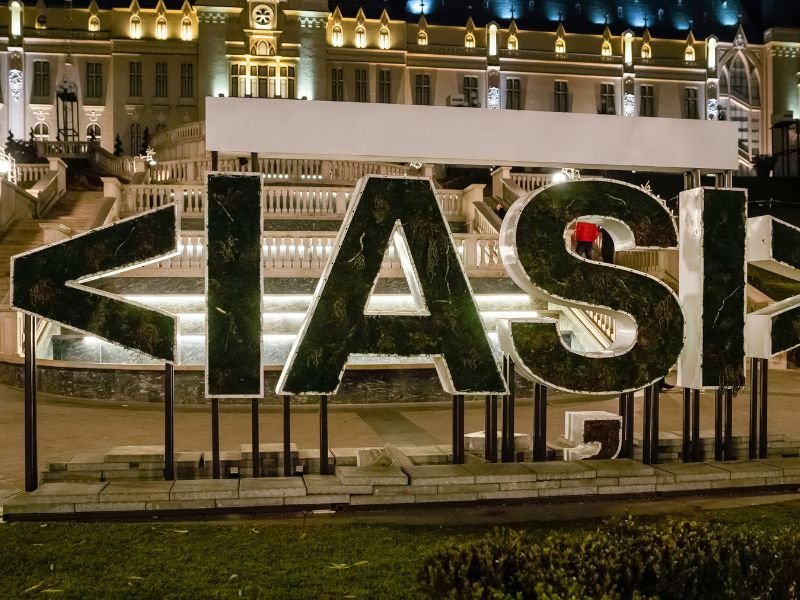
The Historical Heartbeat of Iași
Walking through Iași is like flipping through the pages of a living history book. The city has been a pivotal center for Romanian culture, politics, and education for centuries. Landmarks like the Palace of Culture stand as proud testaments to its storied past. Medieval monasteries and churches dot the landscape, each with tales etched into their walls. Yet, amidst these relics, the city pulses with the energy of today, creating a unique blend of old and new. It’s this juxtaposition that gives Iași its undeniable allure.
- Visit the Metropolitan Cathedral, one of Romania’s largest Orthodox churches.
- Explore Alexandru Ioan Cuza University, the oldest higher education institution in the country.
- Wander through Copou Park, home to the famous Mihai Eminescu’s Linden Tree.
Tip: Wear comfortable shoes—the best way to experience Iași’s historic sites is on foot!
source: Romaniac on YouTube
A Cultural Kaleidoscope
Iași isn’t just about monuments; it’s a hub of arts and culture. The city boasts numerous theaters, museums, and galleries that showcase both traditional and contemporary works. Festivals enliven the city throughout the year, celebrating everything from literature to film. The local art scene is vibrant, offering insights into Romania’s evolving cultural landscape. And let’s not forget the music—whether it’s classical concerts or modern gigs, Iași has it all.
- Catch a performance at the Vasile Alecsandri National Theater, the oldest theater building in Romania.
- Visit the Moldova National Museum Complex for a deep dive into art and history.
- Experience local talent at the Iași Philharmonic Orchestra concerts.
Tip: Check out the city’s event calendar before your trip to catch festivals like the International Literature and Translation Festival.
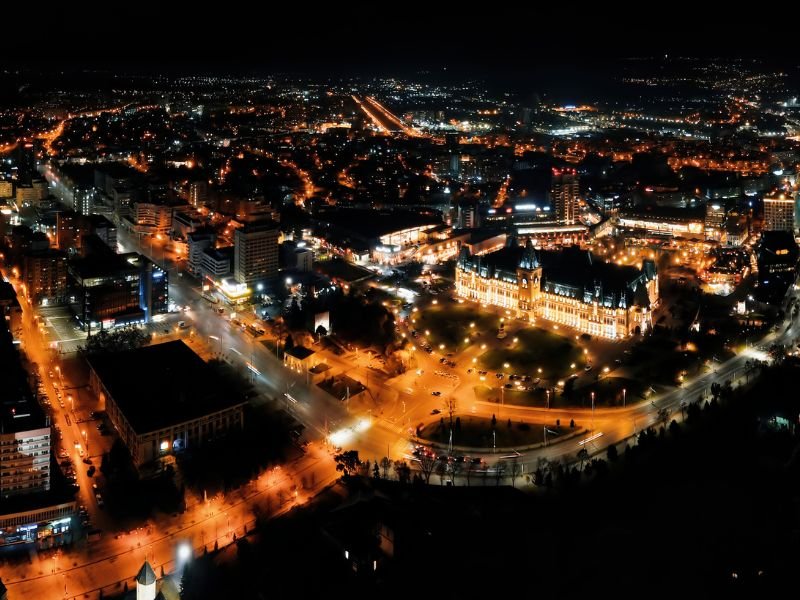
Culinary Delights and Nightlife
When the sun sets, Iași doesn’t slow down. The city’s culinary scene is a delightful mix of traditional Romanian flavors and international cuisine. Cozy cafes, bustling bistros, and elegant restaurants offer something for every palate. As for nightlife, Iași’s student population ensures there’s always somewhere to go. From laid-back pubs to lively clubs, the city caters to those looking to unwind or dance the night away.
- Savor traditional dishes like mămăligă (polenta) and sarmale (stuffed cabbage rolls) at local eateries.
- Enjoy a coffee at Casa Bolta Rece, a historic spot frequented by famous Romanian figures.
- Experience the vibrant atmosphere at Piața Unirii, especially on weekends.
Tip: Don’t miss trying locally produced wines—Iași is near some of Romania’s renowned vineyards!
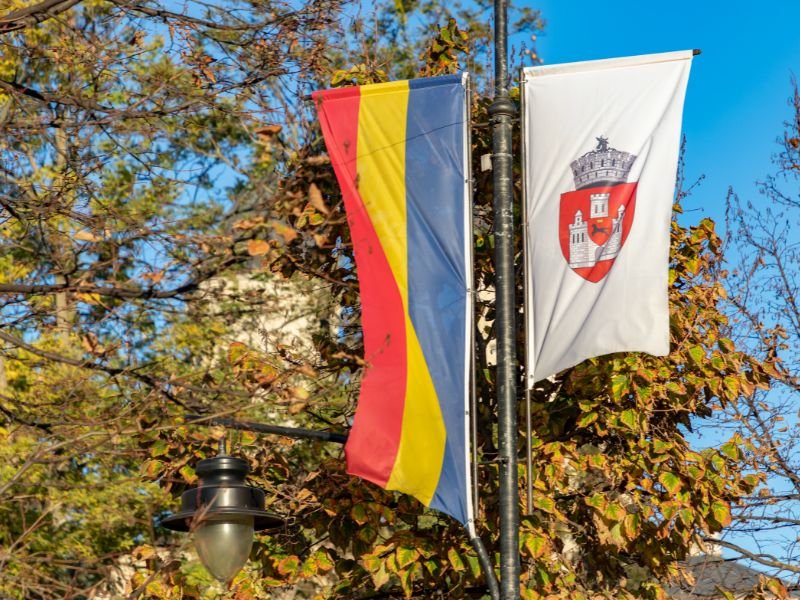
Iasi Top Attractions and Best Places to Visit in Romania
These days, Moldova is its own country. However, more than a century ago, it was part of a united Romania. At that time, Iasi was the capital of the region of Moldavia. Consequently, it is a centre of culture related to Moldova, despite still being part of modern-day Romania.
Our Iasi Travel Guide advises you to take plenty of time to enjoy Iasi’s cultural attractions – set aside a minimum of 3-4 days. Come check out our Iasi travel guide as we cover the best things to do in Iasi, Romania.
Devote your first day in Iasi towards seeing the Palace of Culture. Formerly home to the Administrative and Justice Palace, it now hosts four distinct museums. The first of these is the Art Museum – within this subsection, you’ll find Romania’s oldest visual art collection. It contains over 8,700 pieces, divided into three galleries – modern, contemporary, and universal.
After you get your fill of art, walk over to Moldavia’s History Museum. As the name suggests, this institution chronicles the history of the nearby country of Moldova. You’ll find 48,000 items that date all the way back to the Paleolithic Age. Of them, a 70,000-year-old mammoth skull is among its most prominent holdings.

Other Attractions
Learn even more about the culture of Moldova by checking out the Ethnographic Museum of Moldavia. This institution uses its 13,000 items to weave a narrative about the Moldavian people. Agricultural implements, the typical peasant homes, and traditional costumes are just a few things you’ll encounter here.
Lastly, take a look at the Palace of Culture’s newest attraction – the Science and Technology Museum. Founded in 1955 as the Polytechnical Museum, curators changed the focus to science and technology in 1994. Here, you’ll learn about everything from mineralogy to computers – all with a Romanian bent.
With your appetite for museums satisfied, move on to the Trei Ierarhi Monastery. Authorities built this 17th-century Orthodox monastery to honour saints John Chrysostom, Basil of Caesarea, and Gregory of Nazianzus.
As a significant city in Romania’s past, this monastery became the final resting place of numerous royals. This list includes Alexandru Ioan Cuza, the first ruler of the united Romanian state. The building’s design belies its importance, as it combines numerous architectural styles (Gothic, Renaissance, Persian, Ottoman, and more) in a way that works.
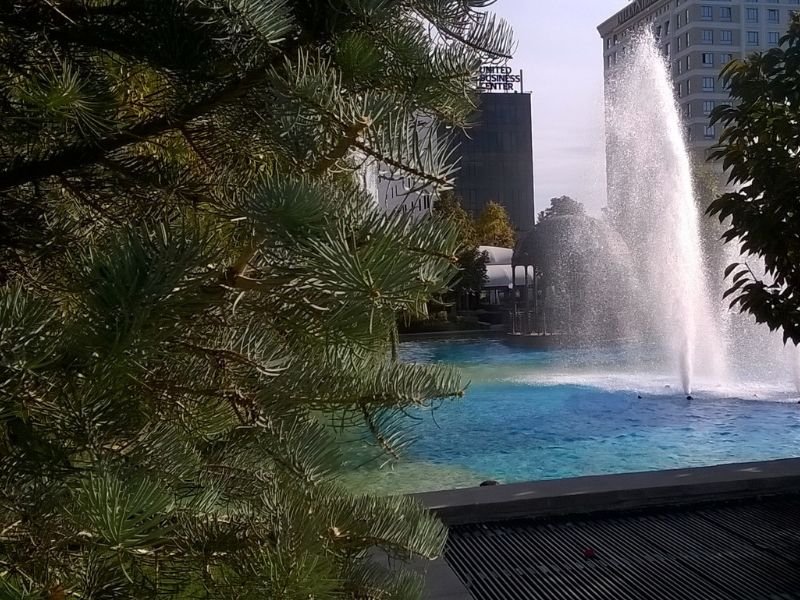
More Attractions
As of this writing, this monastery is on a tentative list for inclusion as a UNESCO World Heritage Site. As such, we strongly recommend checking this place out, even if you aren’t usually interested in religious monuments.
If you are interested in religious monuments, continue on to the Metropolitan Cathedral. Its highest spires are almost 53 metres high, making it the most significant Orthodox church in Romania. It dates from the early 19th century when Prince Ioan Sturdza ordered its building.
This cathedral’s builders crafted it in the Baroque style. Famed Romanian painter Gheorghe Tattarescu created the frescoes and other visual art pieces within. Enjoy your time here, but take care not to disturb worshippers. Dress respectfully and refrain from using flash photography.
Fans of the performing arts may want to take in a show at the Vasile Alecsandri National Theater. Also known as the Iasi National Theater, it takes its official name from the famed Romanian playwright. In this hall, the first play ever presented in the Romanian language took place.
Watching a show here is a special experience. The building, crafted in the Neoclassic, Baroque, and Rococo styles, creates an atmosphere that elevates any play held here. If you love opera houses and theatres, give it a look.
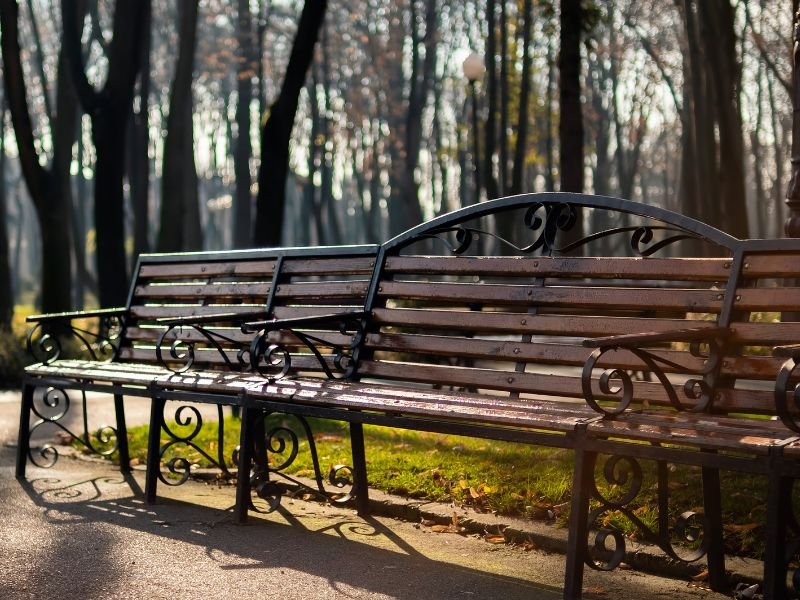
Other Cultural Attractions: Trip to Iasi, Romania
Familiar with one of Romania’s most celebrated writers? While in Iasi, check out the House Of Ion Creanga. It was here where he spent his childhood. He leveraged his memories here to write many of the stories that Romanians know him for.
The curators have done their best to preserve the yard and house as it was back in Ion’s time. To get in only costs 2 EUR, so if you love writers, check the place out.
Green thumbs will want to spend some time strolling through the Iasi Botanical Garden. It spans over 80 hectares, which gives you plenty of room to roam around. The groundskeepers have divided the complex into 12 sections. These gardens include sections on Romanian species, ornamental plants, and much more.
Of all the green spaces in Iasi, Copou Park is the best-loved of all. Founded in 1834, it was the preferred leisure place for Iasi’s elite. While access was open to all, many in lower-classes shunned the park to avoid judgment by influential people. Apart from being a much friendlier place to relax these days, it also hosts festivals and other public events.
If the weather is not cooperating during your visit, spend an afternoon at the Palas Iasi. This centrally-located shopping mall is massive, containing almost 200 shops. Its food court is also well-regarded, so take your time when choosing where to eat your lunch.
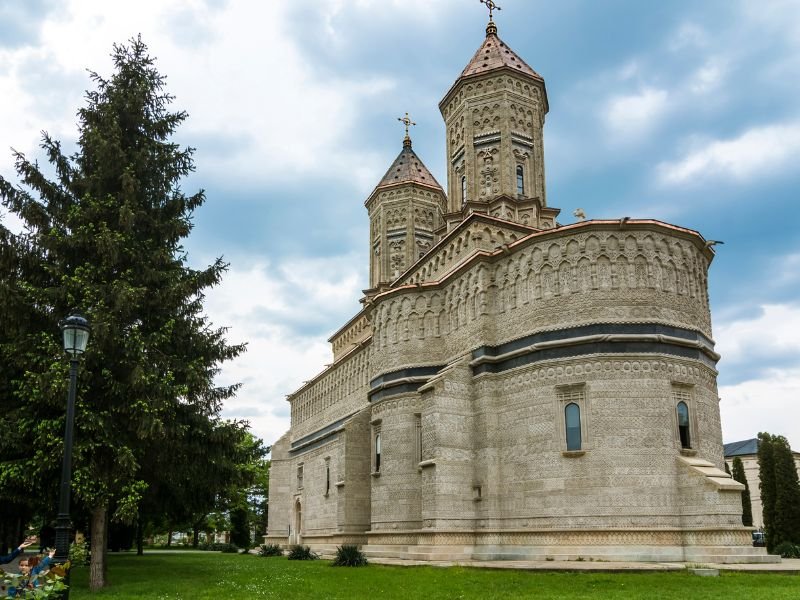
Top 16 Things To Do in Iasi, Romania For Visitors
Let’s explore some must-do activities that will make your visit to Iași unforgettable.
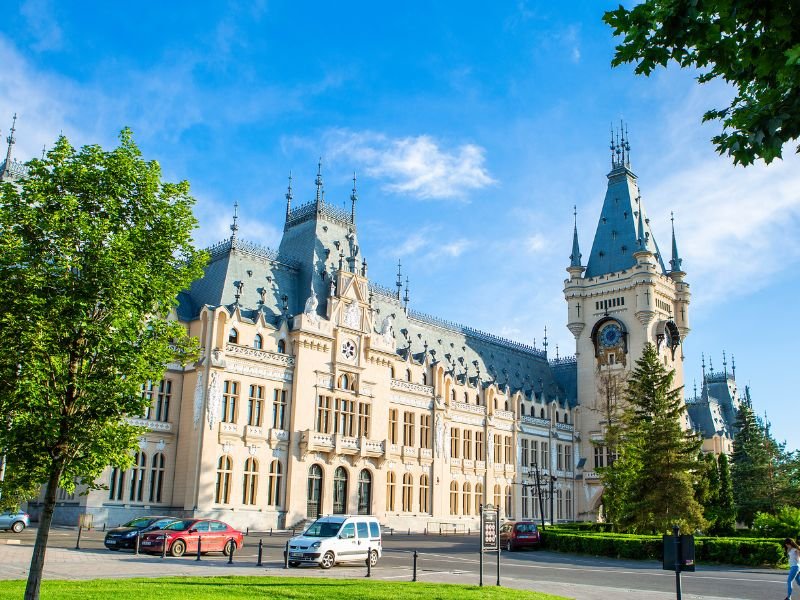
1. Discover the Palace of Culture
The Palace of Culture is undeniably the crown jewel of Iași’s architectural heritage. This imposing structure, built in the early 20th century, showcases a stunning blend of Gothic and Renaissance styles. Inside, you’ll find four museums covering everything from history and art to technology and ethnography. It’s a place where every corner tells a story, inviting you to dive deep into Romania’s cultural past. Don’t miss the chance to climb the clock tower for panoramic views of the city.
- Art Museum: Explore a diverse collection of Romanian and European masterpieces.
- Moldavia History Museum: Delve into the region’s fascinating past through interactive exhibits.
- Ethnographic Museum: Discover traditional Romanian crafts and folk art.
Tip: Plan your visit in the morning to avoid the crowds and enjoy the exhibits at your own pace.
2. Stroll Through Copou Park
Copou Park is the perfect spot for a tranquil escape from the city’s hustle and bustle. Known as the oldest public garden in Romania, this park is a favorite among locals for its serene atmosphere and picturesque setting. Wander along its shaded paths, admire the beautiful flowerbeds, and take a moment to rest under the famous Mihai Eminescu’s Linden Tree. The park is also home to several monuments and statues, adding a touch of history to your leisurely walk. It’s an ideal place to relax, read, or simply enjoy the beauty of nature.
- Mihai Eminescu’s Linden Tree: A historic site where Romania’s beloved poet found inspiration.
- Obelisk of Lions: A striking monument dedicated to the 1834 Organic Statute.
- Junimea Alley: A path lined with busts of famous Romanian writers and cultural figures.
Tip: Visit during the spring or autumn for the most vibrant foliage and a truly picturesque experience.
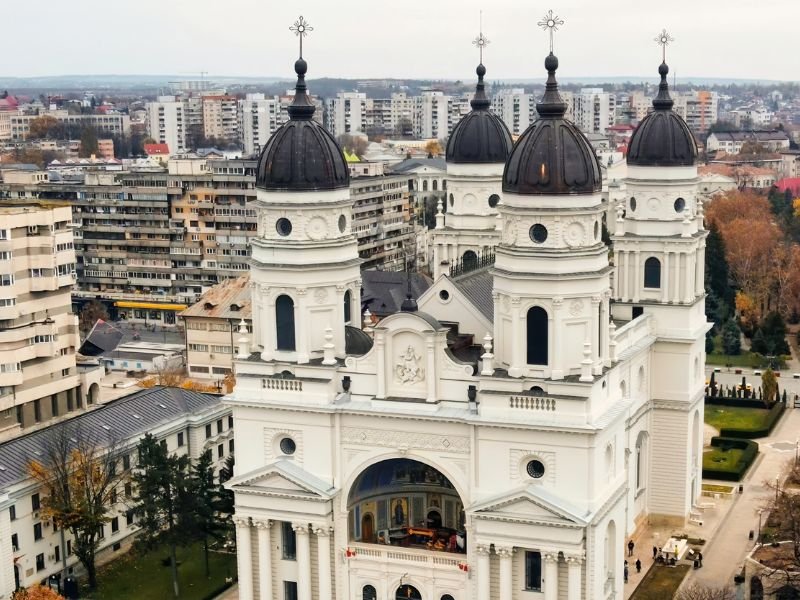
3. Visit the Metropolitan Cathedral
The Metropolitan Cathedral is a stunning example of neo-Romanian architecture and a significant religious site in Iași. Its impressive domes and intricate mosaics make it a must-see attraction for anyone interested in art and history. Step inside to admire the beautiful frescoes and the peaceful ambiance that fills the space. The cathedral is not just a place of worship but also a symbol of the city’s spiritual life and resilience. Whether you’re religious or not, the serene atmosphere and architectural beauty make it a worthwhile stop.
- Stunning Frescoes: Admire the detailed artwork that adorns the cathedral’s walls and ceilings.
- Grand Dome: Gaze up at the impressive dome, a highlight of the cathedral’s architecture.
- Spiritual Significance: Experience the serene and contemplative atmosphere.
Tip: Attend a Sunday service to witness the cathedral’s lively community and hear the beautiful choir music.
4. Wander Through the Botanical Garden
The Anastasie Fătu Botanical Garden is a sprawling oasis of greenery, perfect for nature lovers and anyone looking to unwind. Spanning over 100 hectares, it’s one of the largest and oldest botanical gardens in Romania. Explore themed sections like the Japanese Garden, the rose gardens, and the tropical greenhouse, each offering a unique glimpse into the world of plants. Whether you’re interested in botany or just looking for a peaceful place to walk, the Botanical Garden is a delightful retreat. Bring a book or a camera and let yourself be surrounded by the beauty of nature.
- Exotic Greenhouse: Discover tropical plants and vibrant flowers from around the world.
- Japanese Garden: Experience tranquility in this beautifully designed space with traditional Japanese elements.
- Rose Garden: Wander through a stunning array of roses in various colors and fragrances.
Tip: Pack a picnic and enjoy lunch amidst the lush scenery—there are plenty of spots to spread out and relax.
5. Experience Local Flavors at Piața Unirii
If you’re looking to experience the true taste of Iași, head to Piața Unirii for a culinary adventure. This lively square is surrounded by cafes, restaurants, and food stalls offering a delicious array of traditional Romanian dishes. From hearty stews to freshly baked pastries, there’s something to satisfy every craving. It’s also a great place to people-watch and soak in the vibrant atmosphere. Don’t forget to try some local wines and craft beers, which perfectly complement the hearty Romanian cuisine.
- Traditional Dishes: Savor classics like sarmale (stuffed cabbage rolls) and mici (grilled sausages).
- Local Pastries: Treat yourself to a sweet cozonac or a plate of fluffy papanasi.
- Outdoor Dining: Enjoy your meal al fresco with views of the bustling square.
Tip: Visit in the evening when the square is beautifully lit and the lively atmosphere is at its peak.
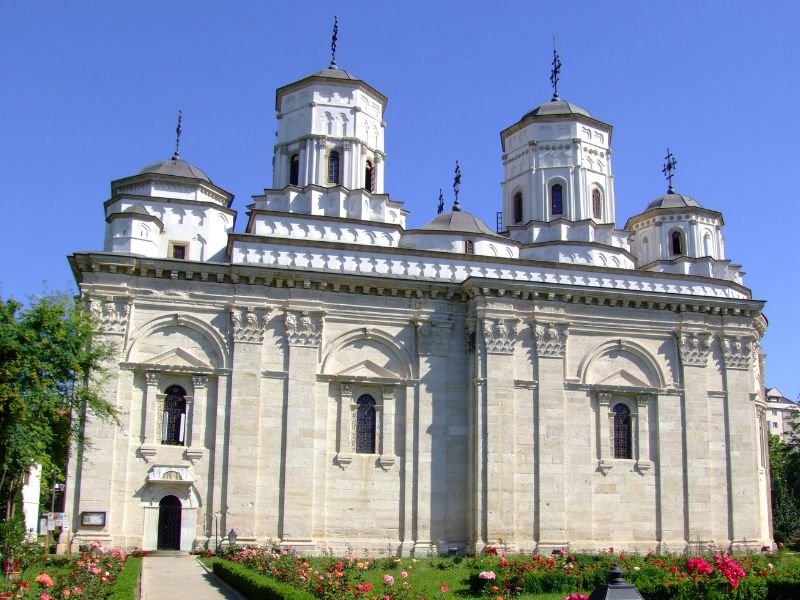
6. Marvel at the Golia Monastery
The Golia Monastery is a striking 17th-century architectural masterpiece nestled in the heart of Iași. Its towering bell tower, one of the tallest in Romania, offers breathtaking panoramic views of the city. The monastery itself is an exquisite blend of Baroque and Byzantine styles, with intricate frescoes and beautifully detailed facades. Inside, the peaceful atmosphere invites quiet reflection, making it a perfect retreat from the bustling city streets. Whether you’re interested in history, architecture, or just looking for a serene spot, Golia Monastery is a must-visit.
- Bell Tower: Climb to the top for stunning views of Iași and the surrounding countryside.
- Intricate Frescoes: Admire the detailed artwork that decorates the monastery’s interior.
- Tranquil Courtyard: Take a moment to relax in the peaceful courtyard, surrounded by history.
Tip: Visit early in the morning for the best light and fewer crowds, allowing for a more personal experience.
7. Explore the Union Museum
For history buffs, the Union Museum offers a fascinating look into the events leading up to the unification of Romania in 1859. Housed in the former residence of Prince Alexandru Ioan Cuza, the museum features exhibits that highlight the pivotal moments and figures in Romanian history. You’ll find original documents, artifacts, and personal belongings of Cuza and other historical figures. Walking through the elegantly furnished rooms, you can almost feel the weight of history and the spirit of national unity that this place represents. It’s a compelling journey through time and a must-see for anyone interested in Romania’s past.
- Historic Artifacts: View original documents and personal items from the time of the unification.
- Elegant Interiors: Explore the beautifully restored rooms, reflecting 19th-century elegance.
- Interactive Exhibits: Engage with multimedia presentations that bring history to life.
Tip: Allow about two hours for your visit to fully appreciate the depth of the exhibits and take part in a guided tour for more detailed insights.
8. Attend a Concert at the Iași Philharmonic Orchestra
The Iași Philharmonic Orchestra is a cultural gem that shouldn’t be missed, especially if you’re a music lover. Housed in a beautiful concert hall, the orchestra is known for its captivating performances, featuring both classical and contemporary compositions. The musicianship is top-notch, and the acoustics of the venue ensure an immersive auditory experience. Attending a concert here is not just about enjoying the music—it’s about feeling the emotional depth and passion that the performers bring to each piece. Whether it’s a symphony, an opera, or a chamber music performance, an evening at the Iași Philharmonic promises to be memorable.
- Diverse Repertoire: Enjoy performances ranging from classical symphonies to modern compositions.
- Talented Musicians: Experience the skill and artistry of some of Romania’s finest musicians.
- Stunning Venue: The concert hall’s architecture and acoustics enhance the overall experience.
Tip: Check the schedule in advance and book your tickets early, especially for popular performances, to secure the best seats.
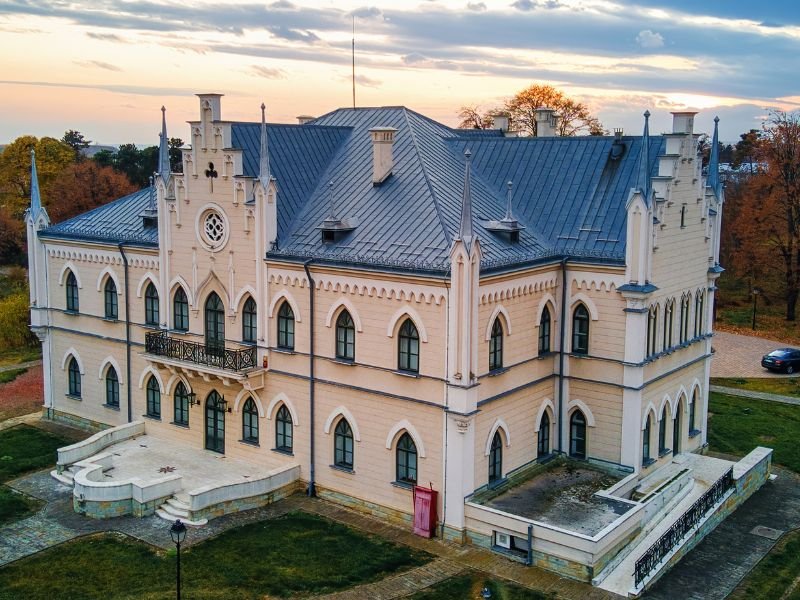
9. Visit the Alexandru Ioan Cuza University
Alexandru Ioan Cuza University is not just the oldest higher education institution in Romania, but also a hub of cultural and intellectual activity. Founded in 1860, the university boasts stunning architecture and a serene campus that’s perfect for a leisurely stroll. The Hall of the Lost Steps, with its impressive frescoes by Romanian artist Sabin Bălașa, is a highlight and a symbol of the university’s artistic heritage. Walking through its historic halls, you can sense the academic excellence and the innovative spirit that has defined this institution for over a century. It’s a place where history and modernity coexist, making it a fascinating stop for any visitor.
- Hall of the Lost Steps: Marvel at the magnificent frescoes that depict Romanian history and mythology.
- Botanical Garden: Visit the nearby garden, which is part of the university, for a peaceful escape.
- Academic Heritage: Learn about the university’s role in shaping Romanian education and culture.
Tip: Take a guided tour to learn more about the university’s history, notable alumni, and its impact on Romanian society.
10. Shop and Dine at Palas Mall
For a more contemporary experience, head to Palas Mall, Iași’s premier shopping and entertainment complex. Situated near the Palace of Culture, this modern mall offers a wide range of retail stores, from high-end brands to local boutiques. It’s a great place to shop for fashion, electronics, and souvenirs. But Palas Mall is more than just shopping—it’s a social hub with a variety of restaurants, cafes, and bars where you can enjoy a meal or a drink while taking in views of the beautifully landscaped gardens. Whether you’re in the mood for a shopping spree, a family outing, or just some people-watching, Palas Mall has something for everyone.
- Diverse Shopping Options: Find everything from luxury brands to unique local products.
- Dining Choices: Enjoy a wide range of cuisine, from traditional Romanian dishes to international flavors.
- Leisure Activities: Relax in the gardens, watch a movie, or enjoy live music events.
Tip: Visit the mall in the evening when the outdoor fountains are illuminated, creating a magical atmosphere perfect for a leisurely stroll.
11. Tour the Mihai Eminescu Museum
The Mihai Eminescu Museum is a must-visit for anyone interested in Romanian literature and culture. Dedicated to the life and work of Romania’s most celebrated poet, Mihai Eminescu, the museum offers an intimate glimpse into his personal and creative world. The exhibits include original manuscripts, personal belongings, and rare photographs that provide insight into Eminescu’s life and his profound impact on Romanian poetry. The house itself, where the poet lived for a period, is beautifully preserved, allowing visitors to step back in time and experience the atmosphere that inspired some of his greatest works. It’s a place of quiet reflection and literary inspiration.
- Original Manuscripts: View Eminescu’s handwritten poems and letters, which reveal his creative process.
- Personal Artifacts: Explore a collection of items that belonged to the poet, from his books to his writing tools.
- Historic House: Walk through the rooms where Eminescu lived and wrote, each carefully restored to reflect the 19th-century setting.
Tip: Take a moment to sit in the garden outside the museum—this peaceful spot is perfect for reading or contemplating the poet’s legacy.
12. Visit the Trei Ierarhi Monastery
The Trei Ierarhi Monastery is a stunning example of Byzantine art and architecture right in the heart of Iași. Built in the 17th century, this historic church is renowned for its intricate exterior carvings, which cover the entire surface of the building. Each detail, from floral patterns to religious icons, is a testament to the skill of the craftsmen who worked on it. Inside, you’ll find beautifully preserved frescoes and an atmosphere of serenity that invites contemplation. The monastery is not only a spiritual center but also a symbol of the city’s rich cultural heritage, making it a must-see for visitors.
- Exquisite Carvings: Admire the detailed stonework that adorns the church’s exterior, showcasing a mix of Gothic, Renaissance, and Oriental influences.
- Historic Significance: Learn about the monastery’s role as a royal burial site and its place in Romanian history.
- Peaceful Interior: Experience the tranquil atmosphere inside, with its ornate altar and sacred relics.
Tip: Visit in the late afternoon when the light is perfect for capturing the intricate details of the monastery’s façade.
13. Explore the Roznovanu Palace
The Roznovanu Palace is a beautiful example of late 18th-century architecture and currently serves as the Iași City Hall. Originally built as a residence for the Roznovanu family, one of the most influential families in Moldavia, the palace has a storied past, including being a temporary royal residence. Today, it stands as a symbol of the city’s political and cultural heritage. Visitors can tour parts of the building, admiring its grand interiors and elegant design. It’s a fascinating place to learn about the city’s history and the role this palace has played over the centuries.
- Elegant Interiors: Walk through rooms adorned with classic furnishings and decor that reflect the palace’s opulent past.
- Historical Exhibits: Explore displays that detail the building’s history and its significance in Iași’s development.
- Architectural Beauty: Appreciate the harmonious blend of Baroque and Neoclassical elements that make the palace a visual delight.
Tip: Check if guided tours are available to gain a deeper understanding of the palace’s history and its famous inhabitants.
14. Step Back in Time at the Cuza Palace in Ruginoasa
A short trip from Iași, the Cuza Palace in Ruginoasa is a beautiful neoclassical building that once served as the summer residence of Alexandru Ioan Cuza, the first ruler of united Romania. The palace is now a museum dedicated to Cuza’s life and legacy, featuring period furnishings, personal items, and exhibits detailing his contributions to the country’s modernization. The surrounding gardens are equally charming, offering a peaceful setting for a stroll. Visiting the Cuza Palace provides a fascinating glimpse into the life of one of Romania’s most important historical figures and is well worth the journey.
- Historical Exhibits: Learn about Cuza’s reforms and his role in unifying Romania through engaging displays and artifacts.
- Restored Rooms: Explore the beautifully restored interiors, each reflecting the style and elegance of the mid-19th century.
- Scenic Gardens: Wander through the landscaped gardens that offer a tranquil escape and stunning photo opportunities.
Tip: Combine your visit with a trip to the nearby town of Pașcani, known for its charming old streets and local markets.
15. Unwind at Ciric Recreation Area
For a bit of outdoor adventure, head to the Ciric Recreation Area, located just a few kilometers from the city center. This popular spot is perfect for those looking to relax and enjoy nature. The area features several lakes, offering opportunities for boating, fishing, or simply enjoying a picnic by the water. There are also walking trails and recreational facilities like tennis courts and playgrounds, making it a great destination for families and active travelers. Whether you’re up for some exercise or just want to enjoy the serene surroundings, Ciric is a wonderful way to experience the natural beauty of Iași.
- Water Activities: Rent a boat or try your hand at fishing on one of the scenic lakes.
- Walking Trails: Explore the network of trails that wind through the forested areas around the lakes.
- Sports Facilities: Play a game of tennis or volleyball at one of the well-maintained courts.
Tip: Visit in the late afternoon to enjoy a peaceful sunset over the lakes, followed by a barbecue at one of the designated picnic spots.
16. Discover Local Crafts at the Central Market
The Central Market in Iași is a bustling hub of activity, offering a colorful array of local products and traditional crafts. From fresh produce and handmade cheeses to vibrant textiles and pottery, the market is a feast for the senses. It’s the perfect place to pick up unique souvenirs and sample some of the region’s culinary specialties. Engage with the friendly vendors, learn about local traditions, and immerse yourself in the lively atmosphere. Whether you’re shopping for gifts or simply exploring, the Central Market is a must-visit for anyone wanting to experience the authentic flavor of Iași.
- Fresh Produce: Find a wide variety of fruits, vegetables, and other local delicacies.
- Handmade Crafts: Browse stalls selling traditional Romanian crafts, including ceramics and embroidered textiles.
- Local Specialties: Taste delicious cheeses, sausages, and baked goods made using time-honored recipes.
Tip: Arrive early in the morning for the best selection and to experience the market at its liveliest.
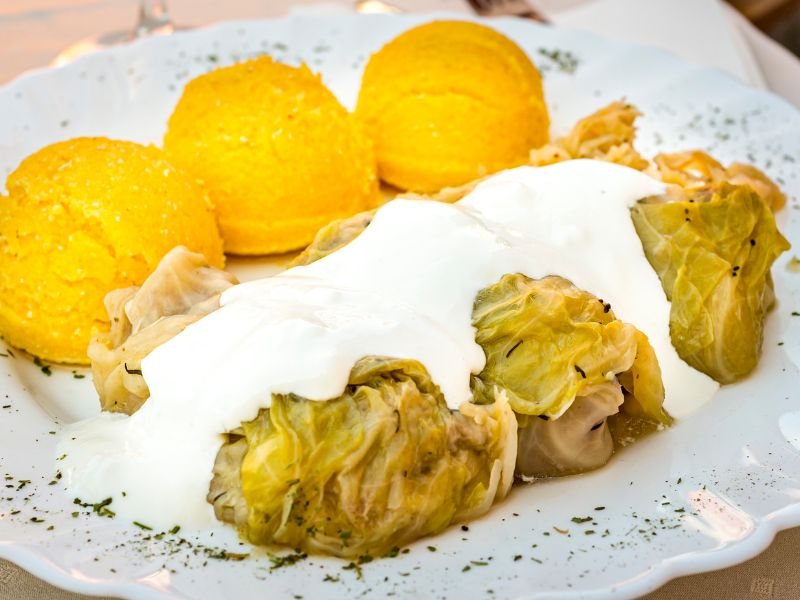
What To Eat and Drink in Iasi, Romania
Here are some must-try eats and drinks in Iași.
1. Savor Traditional Romanian Dishes
Romanian cuisine is hearty, flavorful, and deeply rooted in tradition. In Iași, you’ll find classic dishes like sarmale (cabbage rolls stuffed with minced meat and rice) and mămăligă (polenta), which is often served with cheese, sour cream, and sometimes a fried egg on top. For meat lovers, mititei—grilled minced meat rolls seasoned with garlic and herbs—are a must-try. Each bite is a blend of robust flavors and comforting textures that tell the story of Romania’s culinary traditions. Make sure to pair these dishes with a glass of local wine or a crisp Romanian beer to complete the experience.
- Sarmale: A delicious mix of minced pork or beef, rice, and spices wrapped in cabbage leaves.
- Mămăligă: A traditional cornmeal dish, similar to polenta, often served with cheese and sour cream.
- Mititei: Grilled minced meat rolls, perfect for a hearty and flavorful meal.
Tip: Try these dishes at a traditional restaurant like Bolta Rece or Casa Pogor, where the recipes have been passed down for generations.
2. Indulge in Sweet Treats
Romanian desserts are not to be missed, especially if you have a sweet tooth. Start with papanași, a delightful fried or boiled doughnut-shaped pastry filled with sweet cheese and topped with sour cream and jam. It’s a comforting dessert that strikes the perfect balance between sweet and tangy. Another local favorite is cozonac, a rich, sweet bread often filled with walnuts, cocoa, or poppy seeds, traditionally enjoyed during holidays but available year-round. For something light and refreshing, try plăcintă cu mere—apple pie with a flaky crust and spiced apple filling that will transport you to the heart of a Romanian kitchen.
- Papanași: A decadent fried or boiled pastry filled with sweet cheese, topped with sour cream and jam.
- Cozonac: Sweet, fluffy bread filled with nuts or chocolate, perfect with a cup of coffee or tea.
- Plăcintă cu Mere: A traditional Romanian apple pie with a flaky crust and cinnamon-spiced filling.
Tip: Head to local bakeries like Cuptorul Moldovencei to find these delicious treats fresh out of the oven.
3. Sample Local Wines and Spirits
Romania’s wine culture dates back thousands of years, and Iași is no exception when it comes to showcasing some of the country’s best offerings. The region is particularly known for its Fetească Neagră, a robust red wine with notes of dark fruit and spice. For something white, try the crisp and aromatic Grasă de Cotnari, which hails from nearby vineyards. If you’re in the mood for something stronger, don’t miss out on tasting țuică or palincă, traditional Romanian plum brandies that pack a punch. Sipping these drinks is more than just tasting alcohol—it’s about experiencing a piece of Romanian heritage.
- Fetească Neagră: A rich red wine with flavors of blackberries, plums, and a hint of spice.
- Grasă de Cotnari: A sweet, full-bodied white wine known for its floral and honeyed notes.
- Țuică: A potent Romanian plum brandy, traditionally enjoyed as a digestif.
Tip: Visit a wine bar like Cuib Wine House or Arte Hotel’s Wine Cellar for a curated tasting experience that includes local and regional varieties.
4. Enjoy Street Food Delights
Iași’s street food scene is a delightful mix of flavors and textures, perfect for a quick bite on the go. One of the most popular street foods is covrigi, soft pretzels topped with sesame seeds or salt—crisp on the outside and soft inside. You can also find plăcinte, savory or sweet stuffed pastries filled with cheese, potatoes, or fruits, available at most street corners. Another local favorite is gogoși, fluffy doughnuts sprinkled with powdered sugar, often enjoyed with a side of hot chocolate or coffee. These treats are perfect for satisfying your cravings while exploring the city.
- Covrigi: Freshly baked pretzels, a simple yet delicious snack available at almost every bakery.
- Plăcinte: Romanian pies filled with a variety of sweet or savory ingredients.
- Gogoși: Light and airy doughnuts, best enjoyed fresh and warm with a dusting of powdered sugar.
Tip: Stop by a local bakery or street vendor in Piața Unirii for the freshest and most authentic street food experience.
5. Delight in Traditional Drinks
Romanian beverages go beyond just wine and spirits. Try a traditional socată, a refreshing elderflower drink made from fermented elderflowers, water, lemon, and sugar. It’s lightly fizzy and incredibly refreshing, perfect for a warm day. If you’re visiting in the winter, warm up with a cup of vin fiert—mulled wine infused with spices like cinnamon, cloves, and oranges. For something unique, taste afinată, a sweet liqueur made from wild blueberries, often served as a digestif. These traditional drinks offer a taste of Romanian hospitality and are sure to enhance your culinary adventure in Iași.
- Socată: A sparkling elderflower drink, sweet and tangy, often homemade in Romanian households.
- Vin Fiert: Hot mulled wine, a winter favorite that warms you from the inside out.
- Afinată: A sweet, fruity liqueur made from blueberries, perfect as a post-meal treat.
Tip: Many local restaurants and cafes offer these drinks, but for a truly authentic experience, ask if they have any homemade varieties available.
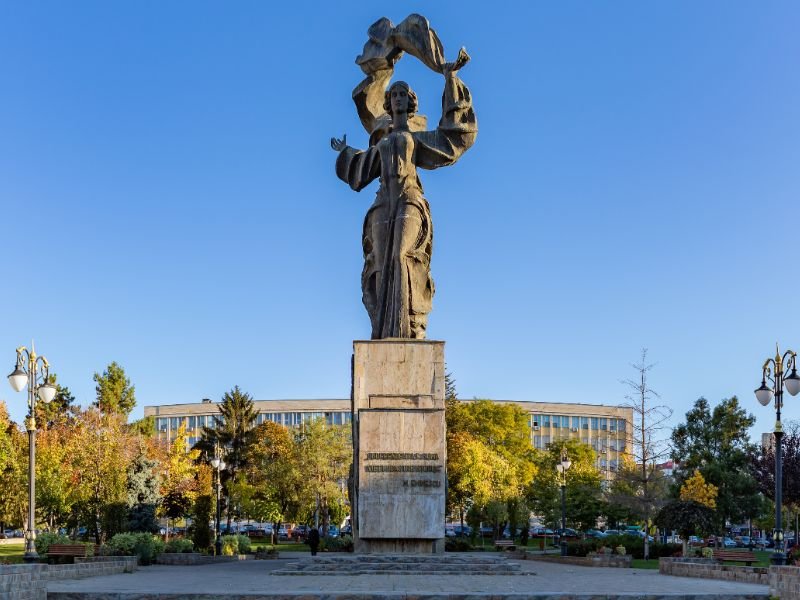
Tours For Visitors To Iasi, Romania
Here are some top tours to consider in Iasi.
1. Historical Walking Tour of Iași
A Historical Walking Tour is the perfect way to immerse yourself in Iași’s past. Led by passionate local guides, this tour takes you through the city’s most significant landmarks, including the Palace of Culture, Union Square, and the Metropolitan Cathedral. As you walk through these historic sites, you’ll hear fascinating stories about the city’s role in Romanian history, from medieval times to the present day. It’s a leisurely paced tour that offers both insight and a chance to appreciate the beauty of Iași’s architecture up close. Whether you’re a history buff or a curious traveler, this tour is a great introduction to the city.
- Palace of Culture: Learn about the architectural marvel and its role in Iași’s cultural scene.
- Union Square: Discover the significance of this historic square and its monuments.
- Metropolitan Cathedral: Explore the stunning neo-Romanian architecture and serene interior.
Tip: Wear comfortable shoes and bring a bottle of water, as the tour covers a lot of ground and includes some uphill walks.
2. Wine Tasting Tour in the Cotnari Region
If you’re a wine enthusiast, a Wine Tasting Tour in the Cotnari Region is a must. Just a short drive from Iași, the Cotnari vineyards are renowned for their unique varietals, including the famous Grasă de Cotnari and Fetească Albă. The tour typically includes a visit to the vineyards, where you can see how the grapes are grown and harvested, followed by a tasting session in a rustic cellar. You’ll have the opportunity to sample different wines while learning about the winemaking process from local experts. It’s a delightful way to spend an afternoon, enjoying both the scenic countryside and the flavors of Romanian wine.
- Vineyard Tour: Stroll through the scenic vineyards and learn about the history of winemaking in the region.
- Wine Tasting: Sample a variety of Cotnari wines, guided by an expert sommelier.
- Cellar Visit: Explore traditional cellars where the wines are aged to perfection.
Tip: Consider booking a tour that includes transportation from Iași, so you can fully enjoy the wine without worrying about the drive back.
3. Iași Monasteries Tour
For a spiritual and cultural journey, the Iași Monasteries Tour offers an insightful look into the city’s religious heritage. This tour typically includes visits to several important monasteries, such as Golia Monastery, Trei Ierarhi Monastery, and the Cetățuia Monastery, each with its own unique architecture and history. You’ll learn about the role these monasteries have played in the region’s history and their influence on Romanian Orthodox traditions. The serene settings and beautiful artwork make this tour a peaceful and enriching experience, ideal for those interested in history, religion, and art.
- Golia Monastery: Marvel at the impressive Baroque architecture and panoramic views from the bell tower.
- Trei Ierarhi Monastery: Admire the intricate stone carvings and rich historical significance.
- Cetățuia Monastery: Enjoy the tranquility of this hilltop monastery and its stunning views over Iași.
Tip: Dress modestly and bring a scarf to cover your shoulders when visiting these sacred sites.
4. Food and Culture Tour
A Food and Culture Tour is the perfect way to experience the flavors and traditions of Iași. This tour combines visits to local markets, traditional bakeries, and family-owned restaurants where you can sample authentic Romanian dishes. Along the way, your guide will share stories about Iași’s culinary heritage and the significance of various dishes in Romanian culture. It’s a sensory journey that goes beyond just tasting food, offering insights into the daily life and traditions of the people of Iași. From sarmale to papanași, this tour is a must for food lovers looking to connect with the local culture.
- Market Visit: Explore a bustling local market and sample fresh produce and artisanal products.
- Traditional Bakery: Taste freshly baked covrigi and other local pastries.
- Authentic Meal: Enjoy a full meal at a local restaurant, featuring classic Romanian dishes.
Tip: Come hungry and be ready to try a little bit of everything—this tour is a feast for the senses!
5. Day Trip to Neamț Fortress and Agapia Monastery
For those looking to venture beyond Iași, a Day Trip to Neamț Fortress and Agapia Monastery offers a perfect blend of history, architecture, and scenic beauty. The tour typically starts with a visit to the Neamț Fortress, a medieval stronghold with panoramic views over the surrounding countryside. You’ll then continue to the Agapia Monastery, known for its stunning frescoes painted by the famous Romanian artist Nicolae Grigorescu. The peaceful monastery grounds and beautiful landscapes make this trip a refreshing escape from the city. It’s a full-day adventure that showcases some of Romania’s lesser-known treasures.
- Neamț Fortress: Explore the historic fortress and learn about its role in defending the region.
- Agapia Monastery: Admire the beautifully preserved frescoes and enjoy the serene atmosphere.
- Countryside Views: Take in the stunning landscapes of the Neamț region, with rolling hills and lush forests.
Tip: Pack a camera and a light jacket, as the weather can be cooler in the hills and the views are truly photo-worthy.
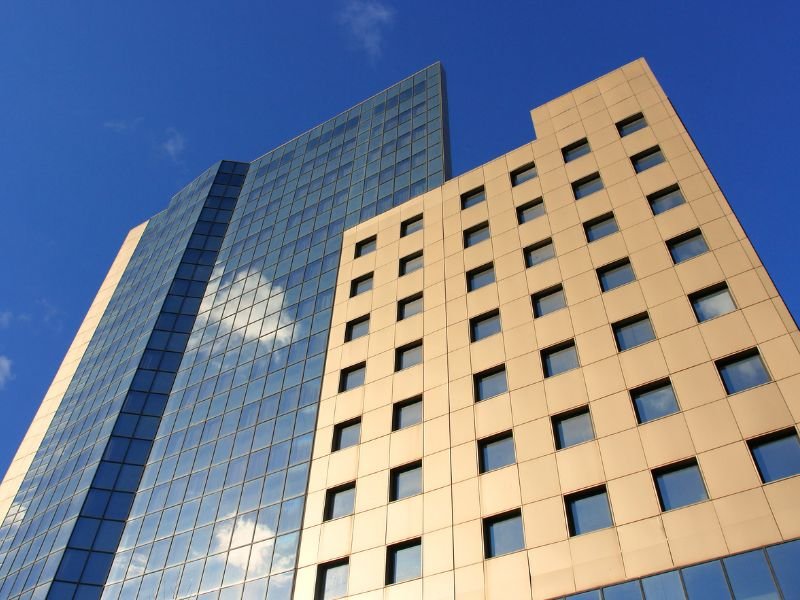
Iasi Accommodations Guide: Hotels, Guesthouses and Hostels
Let’s explore some of the best accommodation options available, so you can find the perfect home base for your stay in Iași.
1. Luxurious Hotels for a Comfortable Stay
For those who prefer a touch of elegance and comfort, Iași has several high-end hotels that deliver top-notch service and amenities. Hotel International Iași is a popular choice, boasting spacious rooms, a rooftop bar with stunning city views, and a full-service spa. Another great option is the Unirea Hotel & Spa, known for its excellent location in the heart of the city and its extensive wellness facilities. If you’re looking for a blend of history and luxury, Grand Hotel Traian offers a unique experience in a beautifully restored 19th-century building. These hotels provide a perfect mix of comfort, convenience, and style, making them ideal for a relaxing stay.
- Hotel International Iași: Modern rooms, an impressive rooftop bar, and a relaxing spa.
- Unirea Hotel & Spa: Centrally located, with an indoor pool and comprehensive wellness services.
- Grand Hotel Traian: Historic charm with luxurious amenities and elegant décor.
Tip: Book early, especially during peak seasons, to secure the best rates and your preferred room type.
2. Charming Guesthouses for a Local Experience
If you’re seeking a more intimate and authentic experience, consider staying at one of Iași’s charming guesthouses. La Conac is a delightful choice, offering traditional Romanian hospitality with a modern twist. Nestled in a quiet neighborhood, it’s perfect for those looking to relax and unwind. Another great option is Pensiunea Novis, which combines cozy accommodations with a welcoming atmosphere and home-cooked meals. For a blend of rustic charm and contemporary comfort, Villa Grande provides spacious rooms and a lovely garden area. These guesthouses offer a personal touch that’s often missing in larger hotels.
- La Conac: A peaceful retreat with beautifully decorated rooms and traditional cuisine.
- Pensiunea Novis: Homey vibe, delicious breakfasts, and friendly hosts.
- Villa Grande: Spacious rooms, a tranquil garden, and a family-friendly environment.
Tip: Communicate with the guesthouse staff directly for special requests—they’re often more accommodating than larger hotels.
3. Budget-Friendly Hostels for Savvy Travelers
Traveling on a budget? No problem. Iași has several excellent hostels that offer comfort and convenience without breaking the bank. Ithaca Hostel is a top choice, located close to the city center and featuring clean dorms, a friendly atmosphere, and plenty of common spaces to meet fellow travelers. For a more unique experience, try Hostel Andrei, which offers a quirky, artsy vibe and a variety of room options, from private suites to shared dorms. Unirii Square Hostel is another great pick, especially for those who want to be close to the main attractions and nightlife. These hostels are perfect for backpackers and budget-conscious visitors.
- Ithaca Hostel: Central location, cozy common areas, and a welcoming community feel.
- Hostel Andrei: Artistic ambiance, affordable rates, and a range of accommodation options.
- Unirii Square Hostel: Ideal for exploring the city, with a social vibe and convenient facilities.
Tip: Check out hostel events or communal dinners—they’re a great way to connect with other travelers and get insider tips about the city.
4. Family-Friendly Accommodations for a Comfortable Stay
Traveling with family? Iași offers a variety of family-friendly accommodations that cater to both adults and children. Pleiada Boutique Hotel is an excellent choice, featuring spacious family rooms, an indoor pool, and a kid-friendly restaurant menu. Hotel Moldova is another great option, located near the Palace of Culture, with amenities like a children’s play area and babysitting services. For a more homely feel, consider Pensiunea La Plopii Fără Soț, which provides comfortable family suites and a large garden where kids can play. These options ensure a hassle-free stay for families visiting Iași.
- Pleiada Boutique Hotel: Family rooms, indoor pool, and kid-friendly dining options.
- Hotel Moldova: Convenient location, play areas, and babysitting services.
- Pensiunea La Plopii Fără Soț: Spacious suites, garden space, and a welcoming atmosphere.
Tip: Book family accommodations with additional amenities like cribs, high chairs, and play areas to make your stay more convenient.
5. Unique Stays for a Memorable Experience
Looking for something out of the ordinary? Iași has several unique accommodations that offer more than just a place to sleep. Conac Polizu is a stunning mansion located just outside the city, perfect for a romantic getaway or a special occasion. This historic estate features elegant rooms, a sprawling garden, and a gourmet restaurant. For a more contemporary vibe, TreeHouse Apartment provides a unique living space with modern design and panoramic city views. If you’re an art lover, consider staying at Art’Hotel, which combines boutique accommodations with an art gallery showcasing local artists. These unique stays add an extra layer of charm and exclusivity to your visit.
- Conac Polizu: Luxurious mansion with beautiful grounds and gourmet dining.
- TreeHouse Apartment: Modern, stylish apartments with stunning views of Iași.
- Art’Hotel: Boutique hotel meets art gallery, perfect for culture enthusiasts.
Tip: For a special experience, inquire about packages or exclusive offers, such as private tours or gourmet dinners.
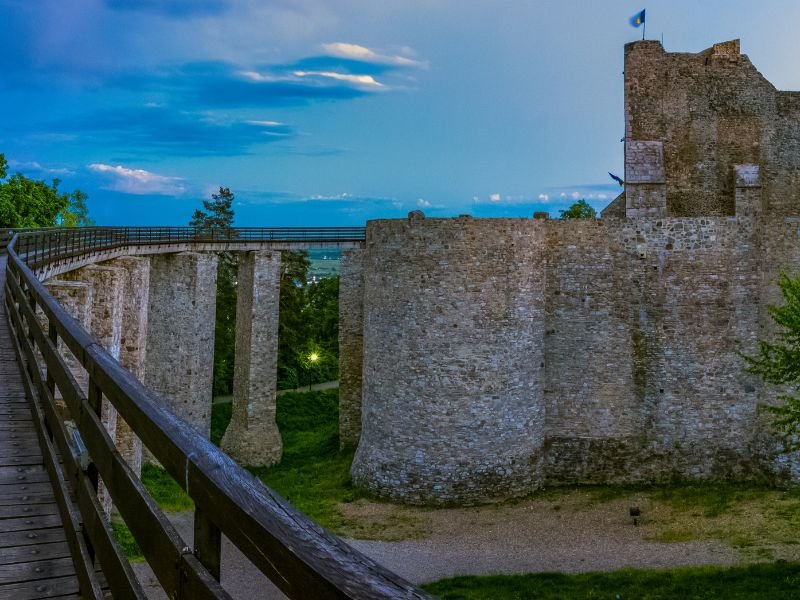
Day Trips From Iasi, Romania
Here are some top day trips from Iași that you won’t want to miss.
1. Neamț Fortress and Agapia Monastery
A day trip to Neamț Fortress and Agapia Monastery is a perfect blend of history and tranquility. Start your journey with a visit to the Neamț Fortress, a medieval stronghold perched on a hilltop with sweeping views of the surrounding valleys. Explore the well-preserved walls and towers, and learn about its role in defending the region against invaders. Next, head to the peaceful Agapia Monastery, known for its stunning frescoes painted by the famous Romanian artist Nicolae Grigorescu. The serene monastery grounds and beautiful landscapes make it an ideal spot for reflection and relaxation.
- Neamț Fortress: Discover the medieval architecture and enjoy panoramic views of the countryside.
- Agapia Monastery: Admire the exquisite frescoes and the tranquil atmosphere of this historic monastery.
- Countryside Views: Take in the picturesque landscapes that surround these historic sites.
Tip: Wear comfortable shoes for the climb up to Neamț Fortress, and don’t forget your camera for the breathtaking views.
2. Visit the Painted Monasteries of Bucovina
The Painted Monasteries of Bucovina are a UNESCO World Heritage Site and a must-see for anyone interested in art and history. These 15th and 16th-century monasteries are famous for their vibrant exterior frescoes, which depict scenes from the Bible in vivid detail. Each monastery has its own unique style and story, with the Voroneț Monastery often referred to as the “Sistine Chapel of the East” due to its stunning blue frescoes. A guided tour of these monasteries offers a fascinating insight into Romanian Orthodox traditions and the artistry of the time. It’s a day filled with culture, beauty, and spiritual depth.
- Voroneț Monastery: Known for its striking blue frescoes and intricate artwork.
- Sucevița Monastery: Features a unique blend of Gothic and Byzantine elements in its frescoes.
- Moldovița Monastery: Beautifully preserved with vibrant, detailed frescoes that cover both the interior and exterior.
Tip: Plan your visit early in the day to avoid crowds and have more time to explore each monastery in detail.
3. Explore the Iași Vineyards in Cotnari
Wine lovers will find a day trip to the Cotnari Vineyards an absolute treat. Located just an hour’s drive from Iași, this region is renowned for producing some of Romania’s finest wines, including the famous Grasă de Cotnari. Take a guided tour through the vineyards, where you’ll learn about the history of winemaking in the area and the unique qualities of the local grape varieties. End your visit with a tasting session in a rustic cellar, where you can sample a selection of wines paired with local cheeses and charcuterie. It’s a delightful way to spend a day indulging in the flavors of the region.
- Vineyard Tour: Walk through the scenic vineyards and learn about the winemaking process from grape to glass.
- Wine Tasting: Enjoy a guided tasting session with a variety of Cotnari wines, including some rare vintages.
- Local Pairings: Savor traditional cheeses and cured meats that complement the wines perfectly.
Tip: Check if there are any seasonal wine festivals happening during your visit for an even more immersive experience.
4. Rediscover the City of Roman
The nearby city of Roman is a hidden gem that’s perfect for a leisurely day trip. Start your visit with a stroll through the city center, where you can admire the beautiful architecture of the Roman Catholic Cathedral and the Neoclassical-style Town Hall. The city is also home to the Moldavia Museum, which houses a fascinating collection of artifacts that chronicle the region’s history from ancient times to the modern era. Take some time to explore the peaceful parks and enjoy a meal at a local restaurant to complete your visit. Roman offers a quiet charm and a glimpse into the everyday life of a small Romanian city.
- Roman Catholic Cathedral: A stunning example of Baroque architecture with an ornate interior.
- Moldavia Museum: Explore the history of the region through well-curated exhibits and displays.
- Town Hall Square: A picturesque area surrounded by historical buildings and charming cafes.
Tip: Combine your visit with a stop at the nearby Eternal Life Monastery, known for its serene atmosphere and beautiful surroundings.
5. Discover the Beauty of Bicaz Gorges and Red Lake
For nature enthusiasts, a day trip to the Bicaz Gorges and Red Lake offers breathtaking scenery and a chance to connect with Romania’s natural beauty. Start your adventure with a drive through the winding roads of the Bicaz Gorges, where towering limestone cliffs rise dramatically on either side. The area is perfect for hiking, photography, or simply enjoying the stunning views. Continue to Red Lake, a tranquil body of water surrounded by lush forests and dotted with the remnants of tree trunks rising from its depths. It’s a picturesque spot for a picnic or a boat ride, offering a peaceful escape from city life.
- Bicaz Gorges: Marvel at the dramatic limestone formations and explore scenic hiking trails.
- Red Lake: Enjoy the serene beauty of this natural lake, ideal for boating or relaxing by the shore.
- Wildlife Watching: Keep an eye out for local wildlife, including birds and deer, as you explore the area.
Tip: Pack a picnic and spend some time relaxing by the lake—there are plenty of spots with stunning views.
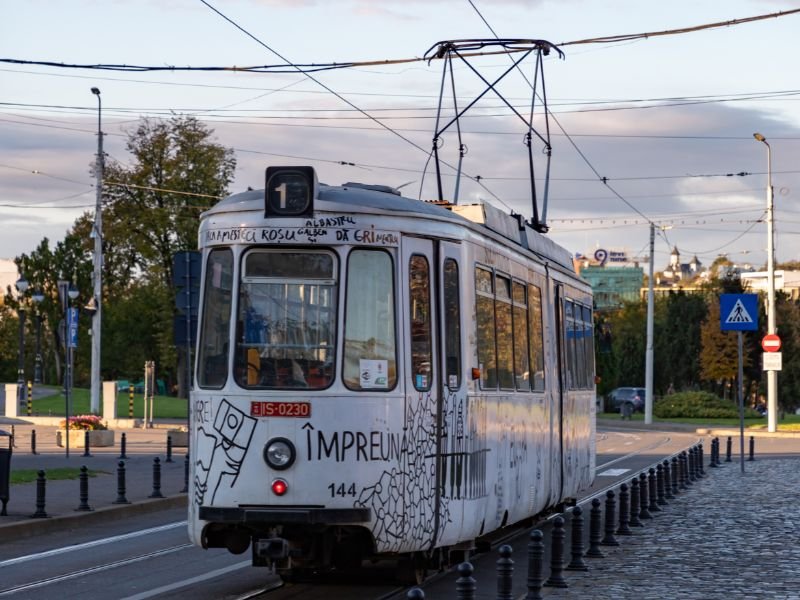
Iasi Transportation Guide
Let’s take a closer look at the best ways to travel around Iași and explore all that this vibrant city has to offer.
1. Public Transportation: Trams and Buses
Iași has an efficient and affordable public transportation network, making it easy to get around the city. Trams and buses run frequently, connecting all major neighborhoods and attractions. The tram system is particularly extensive, with several lines crisscrossing the city, offering a scenic and convenient way to travel. Buses complement the trams, reaching areas that aren’t accessible by tram. Whether you’re heading to the city center or exploring the outskirts, public transport is a reliable choice.
- Affordable Fares: Single tickets and day passes are available, offering budget-friendly travel options.
- Frequent Services: Trams and buses run regularly from early morning until late evening.
- Accessibility: Most trams and buses are equipped with low floors and ramps for easy access.
Tip: Purchase tickets from kiosks near major stops or use the 24pay app for a hassle-free digital ticketing experience.
2. Taxis and Ride-Hailing Services
For those who prefer a more direct mode of transportation, taxis and ride-hailing services like Uber and Bolt are widely available in Iași. Taxis are easy to find at designated stands or hailed from the street, and they provide a comfortable way to reach your destination quickly. Ride-hailing apps offer an added convenience, allowing you to book a ride with just a few taps on your smartphone. Fares are generally affordable, and both options are great for late-night trips or when you’re carrying luggage.
- Availability: Taxis and ride-hailing cars are plentiful, especially in the city center and around popular attractions.
- Convenience: Ride-hailing apps provide estimated fares and driver details, adding a layer of safety and comfort.
- Payment Options: Both cash and card payments are accepted in most taxis and through ride-hailing apps.
Tip: Always check that the taxi meter is on, or agree on a fare beforehand to avoid any misunderstandings.
3. Renting a Car for More Flexibility
Renting a car is a great option if you plan to explore beyond the city or prefer the freedom of having your own vehicle. Iași has several car rental agencies, offering a range of vehicles to suit different needs and budgets. Having a car allows you to visit attractions outside the city, such as the painted monasteries of Bucovina or the scenic vineyards of Cotnari. Just keep in mind that traffic can be heavy during peak hours, and parking in the city center can be a challenge.
- Multiple Agencies: Find car rental options at the airport, city center, and major hotels.
- Wide Range of Vehicles: Choose from compact cars for city driving to SUVs for countryside trips.
- Flexible Rentals: Options for daily, weekly, or long-term rentals, depending on your travel plans.
Tip: Book your car in advance, especially during peak travel seasons, to secure the best rates and availability.
4. Exploring Iași on Foot
Many of Iași’s main attractions are within walking distance of each other, making it an ideal city to explore on foot. Strolling through the city allows you to soak up the local atmosphere, discover hidden gems, and appreciate the beautiful architecture. Start your walk in Union Square, and make your way to the Palace of Culture, stopping by charming cafes and historic churches along the way. Walking is also a great way to find unique shops and restaurants that you might miss when traveling by car or tram.
- City Center: Most landmarks, including the Metropolitan Cathedral and Copou Park, are easily accessible on foot.
- Scenic Walks: Enjoy a leisurely stroll through Copou Park or along the Bahlui River.
- Discover More: Walking lets you explore Iași’s lesser-known spots, from local markets to quiet neighborhoods.
Tip: Wear comfortable shoes and keep a map or smartphone handy—Iași’s streets can be a bit winding and confusing for first-time visitors.
5. Cycling Around the City
Iași is gradually becoming more bike-friendly, with dedicated lanes and bike rental options popping up around the city. Cycling is a fun and eco-friendly way to explore the city at your own pace. You can rent a bike from one of the many stations located near parks and major landmarks. It’s perfect for visiting attractions like the Botanical Garden or exploring the quiet streets of Copou. While the city is hilly, cycling enthusiasts will enjoy the challenge and the rewarding views.
- Bike Rentals: Find bike-sharing stations at key locations like the Palace of Culture and Copou Park.
- Scenic Routes: Enjoy cycling through parks and along the Bahlui River for a more relaxed experience.
- Eco-Friendly: Cycling reduces your carbon footprint and offers a healthy way to see the city.
Tip: Avoid cycling during rush hours and stick to designated bike lanes for a safer experience.
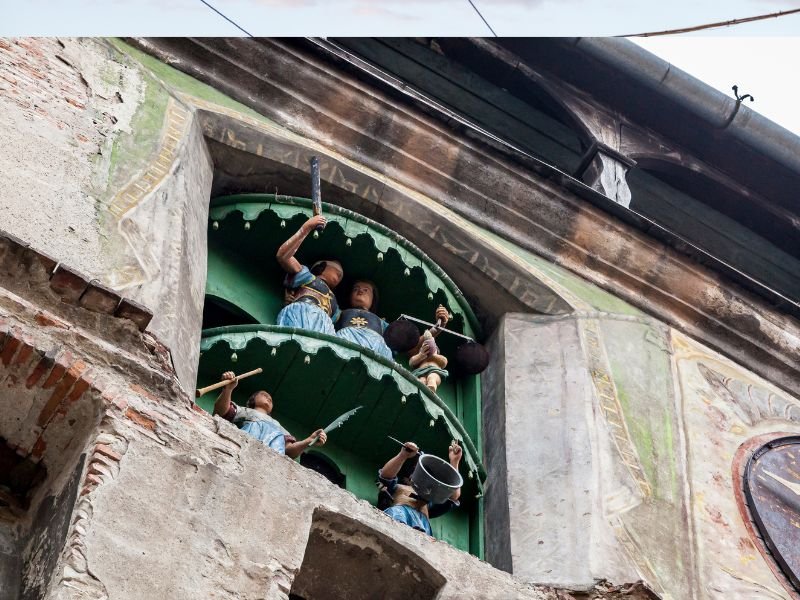
Where To Visit After Your Trip To Iasi?
Here are some top recommendations to consider after leaving Iași.
1. Discover the Medieval Magic of Sighișoara
Sighișoara is a stunning medieval town that feels like stepping back in time. Known as the birthplace of Vlad the Impaler, the historical figure who inspired Dracula, this UNESCO World Heritage Site is packed with colorful houses, narrow cobblestone streets, and a captivating history. Climb the Clock Tower for panoramic views of the city, then wander through the old citadel to soak up the atmosphere. Don’t miss the chance to visit the house where Vlad was born, now a museum and restaurant. It’s a perfect destination for history lovers and anyone looking for a fairytale-like experience.
- Clock Tower: Offers a fantastic view of the town and surrounding areas.
- Birthplace of Vlad the Impaler: A museum and restaurant where you can learn more about this historic figure.
- Medieval Festival: Visit in July to experience reenactments, music, and traditional crafts.
Tip: Stay overnight to see the town illuminated at night—it’s a magical sight that’s not to be missed.
2. Explore the Natural Beauty of the Bucegi Mountains
If you’re craving some outdoor adventure, head to the Bucegi Mountains. This stunning range is part of the Southern Carpathians and offers endless opportunities for hiking, climbing, and nature photography. The trails range from easy walks to challenging treks, catering to all levels of experience. Don’t miss the iconic rock formations of Babele and the Sphinx, which are shrouded in local legend and mystery. After a day of exploration, relax in the nearby town of Sinaia, home to the breathtaking Peleș Castle.
- Babele and the Sphinx: Unique rock formations with mystical significance.
- Peleș Castle: A fairytale-like palace nestled in the forest, perfect for history buffs and architecture lovers.
- Hiking Trails: Numerous paths with varying difficulty, offering stunning views of the mountains.
Tip: Visit in late spring or early autumn for the best weather conditions and fewer crowds on the trails.
3. Enjoy the Vibrant Energy of Bucharest
Bucharest, Romania’s bustling capital, is a city of contrasts where modern life meets rich history. Stroll down Calea Victoriei, one of the oldest and most beautiful streets, lined with elegant buildings, museums, and shops. Explore the grandeur of the Palace of the Parliament, the second-largest administrative building in the world, or wander through the historic Old Town, filled with vibrant cafes, bars, and boutique stores. Whether you’re into art, history, or nightlife, Bucharest has something to offer.
- Palace of the Parliament: A monumental building with guided tours that showcase its opulent interiors.
- Old Town: A lively area with cobblestone streets, perfect for dining and nightlife.
- Herastrau Park: A large, serene park ideal for a leisurely boat ride or a relaxing afternoon.
Tip: Plan to visit some of Bucharest’s many museums, like the National Museum of Art or the Village Museum, for a deeper understanding of Romanian culture.
4. Unwind in the Bucovina Region
For a peaceful retreat, head to the Bucovina Region, famous for its beautifully painted monasteries and rolling green hills. The monasteries, such as Voroneț and Sucevița, are adorned with vivid frescoes both inside and out, depicting biblical scenes and Romanian folklore. These UNESCO World Heritage Sites are perfect for those seeking a spiritual experience or a deeper connection with Romanian heritage. The region also offers charming villages, traditional crafts, and delicious local cuisine that will make your visit unforgettable.
- Voroneț Monastery: Known as the “Sistine Chapel of the East” for its stunning blue frescoes.
- Sucevița Monastery: A mix of Gothic and Byzantine art, surrounded by lush landscapes.
- Traditional Crafts: Discover pottery, wood carving, and weaving in local workshops.
Tip: Hire a local guide to learn the stories and symbolism behind the intricate frescoes of each monastery.
5. Relax by the Black Sea in Constanța
If you’re longing for some sun and sea, make your way to Constanța, Romania’s oldest continuously inhabited city. Stroll along the picturesque seafront, visit the impressive Constanța Casino, and explore the fascinating exhibits at the National History and Archaeology Museum. The nearby beach resorts of Mamaia and Eforie Nord offer sandy beaches, vibrant nightlife, and plenty of water sports. It’s the perfect destination for unwinding after a busy travel itinerary.
- Constanța Casino: A stunning, albeit crumbling, art nouveau building with a rich history.
- Mamaia Beach: Known for its lively atmosphere and excellent facilities for beachgoers.
- National History and Archaeology Museum: Explore artifacts that chronicle the city’s ancient and diverse past.
Tip: Visit during the off-peak season in May or September to enjoy the beaches and attractions without the summer crowds.
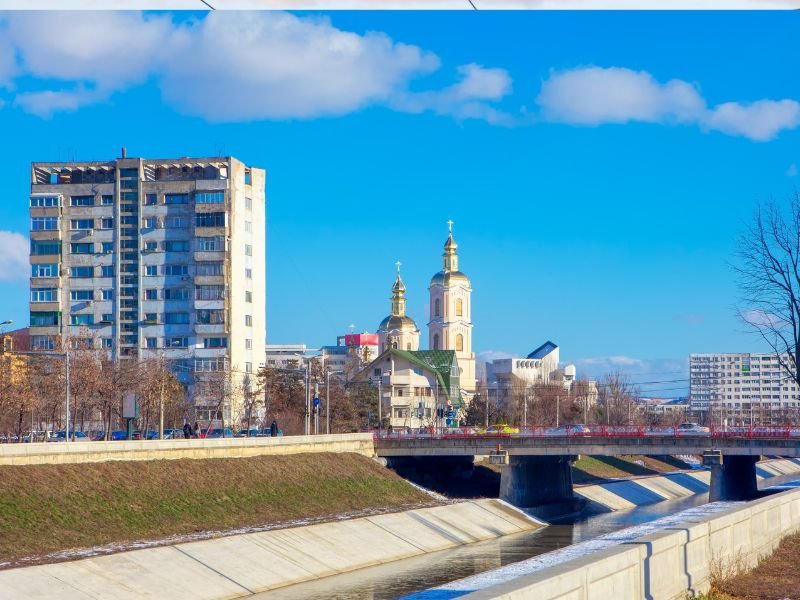
Essential questions about visiting Iași, Romania: trip-planning answers, local-style tips & practical advice
How many days do you really need in Iași for a first-time visit?
Three days. That’s usually the sweet spot for a first trip to Iași. With two full days you can comfortably cover the Palace of Culture, Copou Park, the main monasteries and churches, plus a bit of café hopping and nightlife, but a third day lets you slow down, revisit a favorite museum, or squeeze in something like Ciric Recreation Area or a vineyard visit without feeling rushed. If you’re very short on time, Iași works as an overnight stop, but anything less than one full day in the city and you’ll spend more time in transit than actually soaking up Moldavian culture.
When is the best time of year to visit Iași in terms of weather and crowds?
It depends. If you like mild temperatures and fewer crowds, May–June and September–mid-October are the golden months, with comfortable days for walking, green parks, and lower chances of heatwaves or deep-freeze cold. Summers can get hot and occasionally stormy, and winter is properly cold with snow and icy streets, which is atmospheric around Christmas markets but less fun if you’re planning long walking days. Spring and autumn also line up nicely with the academic calendar, so the city feels lively with students without being overwhelmed by holiday crowds.
How do I actually get to Iași and then reach the city centre from the airport or station?
Luckily, Iași is well plugged in. You can fly directly into Iași International Airport (IAS) from several European hubs, arrive by InterRegio train from cities like Bucharest or Cluj, or use long-distance buses that fan out across Romania and neighboring countries. From the airport, a local bus (usually line 50) runs between the terminal and the central area for a very low fare, and metered taxis and ride-hailing apps like Bolt and Uber are also widely used; the ride into the centre is typically 15–25 minutes depending on traffic. From the train or bus station, you’re only a short tram, bus or taxi ride from Union Square and the Palace of Culture area, so you never feel “stranded on the edge of town.”
Is Iași walkable, or do I really need to rely on trams, buses and taxis?
Mostly walkable. The compact historic core around the Palace of Culture, Union Square, Copou Park and the main churches is very easy to explore on foot, and half the charm is wandering between cafés, parks and viewpoints. That said, Iași is a hilly city and distances stretch out once you start heading to places like Ciric Recreation Area or residential neighborhoods, so you’ll probably end up mixing walking with trams and buses. Public transport is cheap and frequent, and for late nights or when it’s freezing or raining, taxis and ride-hailing apps are inexpensive back-up options.
Which area of Iași is best to stay in for first-time visitors?
For a first visit, I’d aim for the triangle between the Palace of Culture, Union Square and Copou. Staying near the Palace of Culture or Palas complex puts you beside shopping, restaurants, nightlife and tram connections, while Unirii/Union Square is ideal if you want easy access to both the old and new parts of town. Copou is greener and a bit quieter, good if you like parks and the university vibe. If you’re on a tighter budget, neighborhoods a few tram stops away often have better prices while still being 10–15 minutes from the main sights.
Is Iași safe for tourists and are there any scams or areas I should watch out for?
Generally, yes. Iași is considered a safe, relaxed city by Romanian standards, and most visitors have zero issues beyond the usual small annoyances of urban travel. The main things to watch are pickpocketing on crowded trams or during festivals, unlicensed taxis that don’t use the meter, and the odd pushy bar promoter or “overfriendly” stranger late at night. Stick to official taxi ranks or ride-hailing apps, keep bags zipped in crowds, avoid flaunting valuables, and you’ll likely find Iași feels more low-key and comfortable than many Western European cities of a similar size.
How expensive is Iași and what kind of daily budget should I plan for?
Affordable. Compared to Western Europe, your money stretches far in Iași, especially on food and local transport. A rough mid-range daily budget per person might be 60–90 EUR including a comfortable hotel or guesthouse, restaurant meals, museum entries, local transport and a drink or two in the evening; backpackers staying in hostels and cooking some meals can get by on 35–50 EUR, while those leaning into upscale hotels, spa time and fine dining can easily go beyond 120 EUR per day. Wine, coffee and baked goods are particularly good value, so it’s easy to indulge without destroying your budget.
Is Iași a good destination for families traveling with kids?
Absolutely. Iași works very well for families because distances are manageable, parks are plentiful and there’s a nice mix of “grown-up” culture and kid-friendly spaces. Children usually love Copou Park, the Botanical Garden, the Palace of Culture’s interactive exhibits, Ciric Recreation Area with lakes and playgrounds, and the sheer novelty of trams clanking through the streets. Family rooms and apartments are common, restaurants are used to kids and happy to tweak dishes, and day trips like Neamț Fortress or Bucovina monasteries turn into giant real-life history lessons without feeling overly academic.
What should I pack for Iași in each season so I’m not caught out by the weather?
Layers. Winters in Iași are cold with sub-zero nights and the real potential for snow and ice, so you’ll want insulated boots with good grip, a proper winter coat, hat, scarf and gloves if you visit from roughly December to February. Spring and autumn swing between crisp mornings and mild afternoons, so a light down jacket, sweater or fleece and a packable rain shell work well, along with waterproof shoes for wet days. Summers can be hot, so breathable clothing, a sunhat, sunglasses and a reusable water bottle are key, but I still like to pack a light layer for cooler evenings or air-conditioned interiors.
Do I need to rent a car in Iași, or can I rely on public transport and tours for day trips?
Not really. If you’re mainly interested in the city itself plus one or two organized day trips, you can lean on trams, buses, taxis and guided tours without ever touching a steering wheel. A rental car becomes more useful if you want to string together several rural monasteries in one day, explore remote villages at your own pace, or combine Iași with more off-the-beaten-path corners of Moldavia and Bucovina. Just remember that parking around the centre and Palace of Culture area can be tight and often paid, so city-only visitors are usually happier staying car-free.
Can I really visit the painted monasteries of Bucovina or Cotnari vineyards as day trips from Iași?
Yes. The Cotnari wine region is the easier day trip, sitting roughly an hour or so from Iași by car, with tours that combine vineyard walks, cellar visits and tastings of local varieties like Grasă de Cotnari. Reaching the famous painted monasteries of Bucovina (such as Voroneț, Sucevița and Moldovița) is a longer outing—think roughly 3 hours each way by car depending on your exact route—but still doable as a long day with an early start or via a small-group tour that handles logistics. If you’re a slow traveler or photographer, I’d actually consider an overnight in Bucovina so you can enjoy the monasteries in different light and at quieter times of day.
Do people in Iași speak English, or do I really need Romanian to get around?
Relax. You can get by in Iași with basic English, especially in hotels, larger restaurants, museums and places that regularly see visitors or students. Younger locals and university students tend to speak English reasonably well, while older generations may be more comfortable in Romanian or sometimes French. Learning a handful of polite phrases—“bună ziua” (good day), “mulțumesc” (thank you), “vă rog” (please)—goes a long way, and smiling plus simple gestures covers the rest when you’re buying tram tickets or ordering pastries from a busy bakery.
What’s the nightlife like in Iași – quiet and traditional or more of a student party city?
A bit of both. Iași is a major university city, so you’ll find plenty of student bars, casual pubs and late-night spots around the centre and near the main campuses, especially during term time. At the same time, there’s a growing scene of wine bars, cocktail lounges and live-music venues that appeal to travelers who prefer atmosphere over all-night clubbing. If you want a mellow evening, grab a table at a wine bar around Palas or Unirii and watch the city go by; if you’re in the mood to stay out late, follow the student crowds and you’ll quickly spot the livelier streets.
Is Iași wheelchair-friendly and how challenging is it for travelers with limited mobility?
Mixed. Many of the newer areas, shopping centres and some public buildings have ramps, lifts and accessible toilets, but Iași is still an historic city with cobblestones, uneven sidewalks and some steep sections, especially near older churches and viewpoints. Trams and buses are slowly improving with low-floor vehicles, yet not every stop is perfectly step-free and boarding gaps can be awkward. If you or someone you’re traveling with has limited mobility, it’s worth choosing central accommodation close to the Palace of Culture or Union Square, planning taxis or ride-hailing for hills and outlying sights, and double-checking accessibility details with hotels and key attractions in advance.
Is Iași a good base for remote workers and digital nomads?
Yes. Iași has a strong university and IT scene, so you’ll find solid broadband, plenty of cafés with Wi-Fi, and a growing number of co-working style spaces or laptop-friendly coffee shops around the centre and campus areas. The cost of living is low enough that long stays feel very manageable, and on your off-hours you’ve got parks, culture, cafés and day-trip options rather than just a few tourist streets. The main things to think about are seasonality (winter can be dark and cold, summer warm but fun) and your accommodation choice—aim for an apartment or guesthouse with reliable reviews about Wi-Fi speed, good heating or air-con, and quiet at night so you can actually work.
Iasi Travel Guide: Final Thoughts
A City Oozing Culture and History
Iași is more than just a city—it’s a living museum of Romanian history and culture; whether it’s the grandeur of the Palace of Culture or the serene beauty of the Golia Monastery. The city’s numerous museums and galleries offer deeper insights into its role as a cultural and academic hub. Beyond the well-known landmarks, you’ll find hidden gems in the form of quiet courtyards, historic churches, and vibrant neighborhoods.
- Palace of Culture: A symbol of Iași, housing four different museums that showcase art, history, and science.
- National Theatre: One of Romania’s oldest and most prestigious theatres, offering a range of performances.
- Union Square: A historic focal point, often buzzing with local events and celebrations.
The Warmth of Local Hospitality
One of the highlights of visiting Iași is experiencing the warmth and friendliness of its people. Whether you’re asking for directions, dining at a local restaurant, or exploring a small shop, you’ll find that locals are more than willing to share their stories and recommendations. This hospitality extends beyond the city’s tourist spots; even in the quieter neighborhoods, you’ll be welcomed with a smile. Engaging with the community adds a personal touch to your travels and helps you connect with the true spirit of the city. It’s this genuine warmth that often leaves visitors feeling like they’ve found a home away from home.
- Friendly Locals: Don’t hesitate to ask for recommendations—locals love sharing their favorite spots.
- Personal Connections: From shopkeepers to taxi drivers, you’ll encounter people eager to help and chat.
- Local Events: Attend community events or festivals to experience Iași’s lively and welcoming atmosphere.
Exploring Beyond the Main Attractions
While the major landmarks are certainly worth visiting, some of Iași’s most memorable experiences lie off the beaten path. Take the time to wander through the backstreets of neighborhoods like Tătărași or Păcurari, where you’ll discover charming cafes, colorful street art, and hidden courtyards. Visit local markets to sample fresh produce and traditional snacks, or explore the city’s lesser-known parks and green spaces for a peaceful break from the urban hustle. These small, unexpected moments are what truly define a trip to Iași, offering a glimpse into the everyday life of the city and its people.
- Local Markets: Explore places like Hala Centrală for fresh fruits, vegetables, and local delicacies.
- Hidden Courtyards: Discover beautiful, tucked-away courtyards in neighborhoods outside the city center.
- Street Art: Look out for colorful murals and artistic expressions in the streets of Iași.
A Culinary Journey Worth Savoring
Iași’s food scene is a delightful mix of traditional Romanian flavors and modern culinary trends. From hearty dishes like sarmale and ciorbă de burtă to sweet treats like papanași and cozonac, the city’s restaurants and cafes offer a rich variety of options. Be sure to visit local eateries for an authentic taste of Moldovan cuisine, and don’t shy away from trying something new. The city also boasts a growing number of trendy bistros and wine bars, perfect for enjoying a leisurely meal or a casual evening out. Whatever your preference, the flavors of Iași are sure to leave you satisfied.
- Traditional Dishes: Sample local favorites like mămăligă with cheese and sour cream or mici with mustard.
- Sweet Treats: Indulge in desserts like cozonac (sweet bread) or plăcintă cu mere (apple pie).
- Modern Bistros: Explore contemporary dining spots for a fusion of Romanian and international cuisine.
Planning Your Next Adventure
Leaving Iași doesn’t have to mean the end of your Romanian journey. The city is a perfect gateway to explore more of the country’s stunning landscapes and historic towns. Consider a day trip to the picturesque painted monasteries of Bucovina or a scenic drive through the Bicaz Gorges. For a taste of vibrant city life, Bucharest is just a short flight away. Whether you’re seeking natural beauty, cultural experiences, or a mix of both, Romania’s diverse destinations offer something for every traveler.
- Bucovina Monasteries: A UNESCO World Heritage Site, known for their vivid frescoes and serene surroundings.
- Bicaz Gorges: Dramatic rock formations and scenic hiking trails, perfect for outdoor enthusiasts.
- Bucharest: Romania’s bustling capital, full of history, nightlife, and modern attractions.
